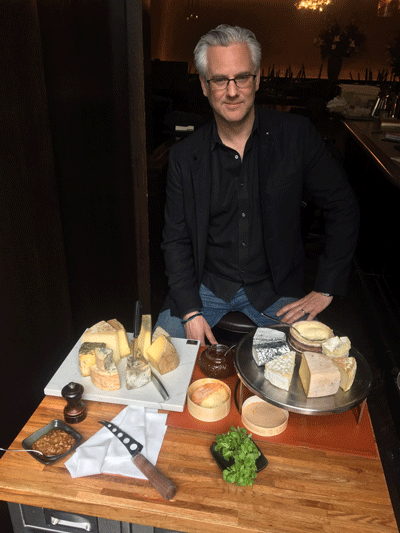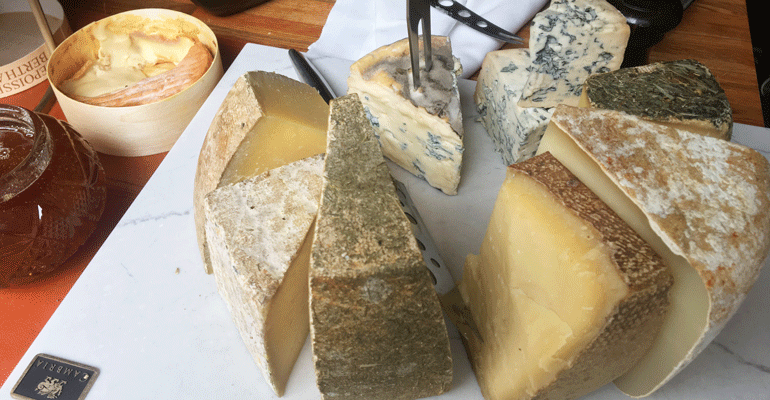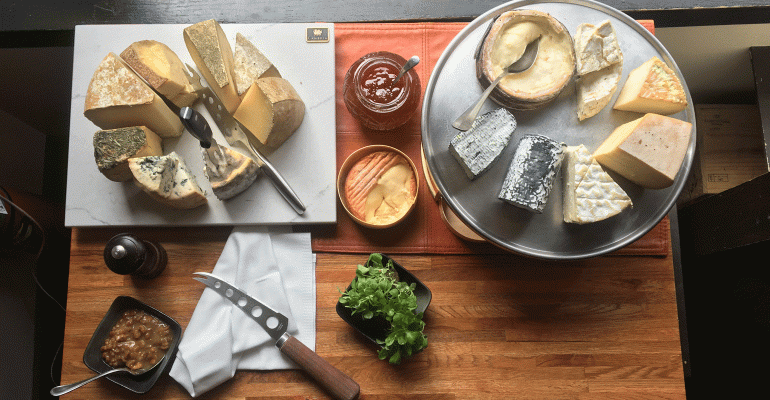Bâtard, the award-winning fine-dining establishment that’s a collaboration of restaurant impresario Drew Nieporent, chef Markus Glocker and front-of-house charmer John Winterman, has become a beloved landmark of the New York City neighborhood of Tribeca by being what most of its competitors, and society at large, aren’t — understated.
Yes, it has a Michelin star, and it won the James Beard Foundation award for best new restaurant in the country when it opened in 2014, and it continues to top everyone’s lists of their favorite restaurants in the city. But Bâtard’s management doesn’t talk about it all day long. It doesn’t tout the farmers it works with or go into long detail about Glocker’s cooking prowess. And when it comes to its highly regarded cheese program, Winterman, the restaurant’s managing partner, manages a sophisticated selection, mostly from great East Coast producers, but he keeps the descriptions simple.
He lists the name, producer, town or region and country, and then “just a basic description of what it is, and I mean ‘ash-ripened goat’s milk,’ ‘natural-rind cow’s milk,’” he said. If it’s a raw-milk cheese, he mentions it because some people are concerned about that, but otherwise, he leaves judgment up to his customers.
“I stay away from trying to categorize them as nutty or stinky or funky or whatever. I let people make their own decisions about that,” Winterman said.
Bâtard’s managing partner has been working with cheese for years, starting in the 1990s in Chicago at Charlie Trotter’s, where he was dining-room manager.
 He then went to San Francisco and worked at restaurant Gary Danko as maître d’. After Winterman was there for a year, the person in charge of that restaurant’s cheese program left and Danko put Winterman in charge, and he ran it for the next three years.
He then went to San Francisco and worked at restaurant Gary Danko as maître d’. After Winterman was there for a year, the person in charge of that restaurant’s cheese program left and Danko put Winterman in charge, and he ran it for the next three years.“That were two cheese carts with roughly 28 cheeses per cart,” Winterman said. “It was a big program.” He was selling 115 cheese plates a night there and he said Danko gave him pretty free rein.
During that time, he met a lot of the great cheesemakers, “and there’s no shortage of cheese available in California, so I got to try a lot of different things, and it was fun featuring everything,” Winterman said.
Bâtard’s program is smaller, with a rotating selection of 12 to 15 cheeses, which he and his staff sell to about 15 customers each night in the 75-seat restaurant.
“We want to keep it focused,” Winterman said. “I don’t order a whole lot at a time. I don’t have space just to keep cheese, and we don’t move it fast enough for me to order too much.”
Instead, he tends to order pieces of 2 pounds to 3 pounds each, to be cut into portions that make up a total of 3 ounces to 5 ounces per cheese plate. He changes his cheese selections frequently.
“Everybody gets a little bit of palate fatigue, and there’s always interesting stuff out there that we haven’t had for a while, or that we forgot about, or that we haven’t tried yet,” he said.
Bâtard charges $18 for three cheeses, $24 for four and $29 for five, but he encourages his servers to add an extra piece — four pieces if they order three, five pieces if they order four, etc. — just as an expression of generosity.
“It’s a little gesture for people,” he said. “There’s always something on the cart that maybe people aren’t choosing as often as we thought they would, or something that’s maybe not even on the cheese list and we have extras, or sometimes we get a lot of samples. The guest doesn’t have to know that it’s a sample, but they get pretty happy about it. It’s a value-added experience that it doesn’t cost us anything to do.”
Besides, cheese isn’t a big profit center for Bâtard.
“It’s profitable overall, but I’m not getting rich off it,” Winterman said. “It’s more an enhancement of the whole dinner experience.”

He said the food cost for the cheese program runs around 40% to 50%, but the labor cost is low.
“You can put together a cheese plate in three minutes,” he said.
Of course, that labor needs training. Apart from providing printouts of the cheese that’s available, Winterman gives them a one-page primer on the history of cheese, “which is very brief, but it gives the idea of how far cheese goes back in our history,” he said. “So they’re walking into it as a 24-year-old learning about cheese for the first time, but they understand that they’re part of a 9,000-year continuum.”
Then he categorizes the cheese into families — washed-rind, surface-ripened, pressed cooked-curd and so on — so they can already have an idea of what a cheese is likely to taste like by looking at it.
He also has them taste new cheeses as they come in, and then encourages them to have fun, but educated fun, with the garnishes.
Glocker and his staff make around eight cheese garnishes available at any given time, including little salad of mâche and celery in hazelnut vinaigrette, a seasonal chutney, balsamic reduction, quince paste, local honey, and other seasonal items, like preserved pumpkin in the fall.
Winterman also takes pictures of different plating styles and teaches them how to cut different types of cheese.
For example, “when a cheese is surface-ripened, there’s a difference between the heart of the cheese and the rind of the cheese, so the guest has to get the whole experience there.”
Unlike at Gary Danko, where customers tended to order a cheese plate for themselves, “I find more often than not that people want cheese for the table to share, so they can have this communal experience together,” he said.
Bâtard always has a few French cheeses, but Winterman likes to focus on cheeses from the Northeast.
“We always carry an Epoisses [from France] and a Camembert, and if we have two blues I’ll have a French and an American one, or sometimes an Australian or British one,” he said. “But featuring cheese from the Northeast was one of my goals. There’s great cheese being made in Vermont and Connecticut and Pennsylvania and Maryland and New York, and I didn’t want to be sitting in the middle of this area with all this great product and not feature it.”
Contact Bret Thorn at [email protected]
Follow him on Twitter: @foodwriterdiary





